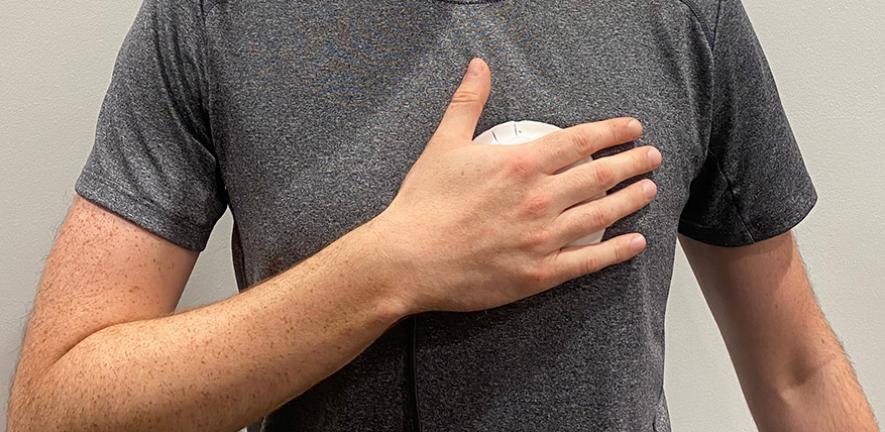剑桥大学研究人员开发可革新心脏病筛查的手持设备
该设备有望成为一种平价、可推广的心脏健康筛查方案,尤其适用于医疗资源有限的地区。
—— 阿努拉格·阿加瓦尔
This device could become an affordable and scalable solution for heart health screening, especially in areas with limited medical resources.
——Anurag Agarwal

研究人员开发出一种新型手持设备,该设备有望取代听诊器成为检测部分类型的心脏病的工具。
Researchers have developed a handheld device that could potentially replace stethoscopes as a tool for detecting certain types of heart disease.
剑桥大学研究人员开发了一种新型设备,无论使用者是否具备医学培训背景,都能轻松准确地记录心音。与传统听诊器不同,该设备即使未精确放置在胸前也能正常运作;它的感应区域更大且更灵活,这能比传统听诊器捕捉到更清晰的心音。
The researchers, from the University of Cambridge, developed a device that makes it easy for people with or without medical training to record heart sounds accurately. Unlike a stethoscope, the device works well even if it’s not placed precisely on the chest: its larger, flexible sensing area helps capture clearer heart sounds than traditional stethoscopes.
The device can also be used over clothing, making it more comfortable for patients – especially women – during routine check-ups or community heart health screening programmes.
记录下的心音可保存在设备中,用于检测心脏瓣膜病的迹象。研究团队还在开发一套可自动识别瓣膜病迹象的机器学习算法。相关研究成果已发表在《IEEE生物医学与健康信息学期刊》上。
The heart sound recordings can be saved on the device, which can then be used to detect signs of heart valve disease. The researchers are also developing a machine learning algorithm which can detect signs of valve disease automatically. The results are reported in the IEEE Journal of Biomedical and Health Informatics.
心脏瓣膜病(瓣膜性心脏病,简称VHD),被称为“下一个心脏流行病”,该疾病预后比许多癌症还要严重。多达50%的中重度VHD患者未被及时诊断,许多患者直到病情加重并出现严重并发症时才就诊。
Heart valve disease (valvular heart disease or VHD) has been called the ‘next cardiac epidemic,’ with a prognosis worse than many forms of cancer. Up to 50% of patients with significant VHD remain undiagnosed, and many patients only see their doctor when the disease has advanced and they are experiencing significant complications.
在英国,国家医疗服务体系(NHS)和国家健康与临床优化研究所(NICE)已将心脏瓣膜病列的早期诊断作为关键目标,以改善患者生活质量并降低医疗成本。
In the UK, the NHS and NICE have identified early detection of heart valve disease as a key goal, both to improve quality of life for patients, and to decrease costs.
通过听诊器进行听诊,是目前诊断心脏瓣膜病的主要手段。然而,仅有38%的疑似瓣膜病患者在向全科医生就诊时接受了听诊检查。
An examination with a stethoscope, or auscultation, is the way that most diagnoses of heart valve disease are made. However, just 38% of patients who present to their GP with symptoms of valve disease receive an examination with a stethoscope.
“VHD的症状常与某些呼吸系统疾病混淆,因此很多患者未能接受听诊检查。” 研究负责人、剑桥大学工程系的阿努拉格·阿加瓦尔教授表示。“而且,通过听诊器诊断心脏瓣膜病的准确率本身并不高,且必须由全科医生进行操作。”
“The symptoms of VHD can be easily confused with certain respiratory conditions, which is why so many patients don’t receive a stethoscope examination,” said Professor Anurag Agarwal from Cambridge’s Department of Engineering, who led the research. “However, the accuracy of stethoscope examination for diagnosing heart valve disease is fairly poor, and it requires a GP to conduct the examination.”
此外,听诊检查通常需要患者脱下部分衣物,这在全科医生的短时间问诊中既耗时,又令患者,尤其是女性患者在例行筛查中感到不适。
In addition, a stethoscope examination requires patients to partially undress, which is both time consuming in short GP appointments, and can be uncomfortable for patients, particularly for female patients in routine screening programmes.
诊断心脏瓣膜病的“金标准”是心脏超声检查,但这只能在医院进行,且NHS的等候名单非常长——许多医院的排队时间为6到9个月。
The ‘gold standard’ for diagnosing heart valve disease is an echocardiogram, but this can only be done in a hospital and NHS waiting lists are extremely long – between six to nine months at many hospitals.
“为了减少候诊人数,并确保能足够早地诊断出心脏瓣膜疾病,以便通过简单的干预措施来提高患者的生活质量,我们希望开发一种可替代听诊器的简便筛查工具。”阿加瓦尔表示。
“To help get waiting lists down, and to make sure we’re diagnosing heart valve disease early enough that simple interventions can improve quality of life, we wanted to develop an alternative to a stethoscope that is easy to use as a screening tool,” said Agarwal.
阿加瓦尔和团队研发了一种或可成为理想解决方案的手持设备,其尺寸约与杯垫相当。该设备可供任何健康专业人员使用,能准确记录心音,且能隔着衣物操作。
Agarwal and his colleagues have developed a handheld device, about the diameter of a drinks coaster, that could be a solution. Their device can be used by any health professional to accurately record heart sounds, and can be used over clothes.
常规或电子听诊器通常仅有一个传感器,而剑桥团队研发的设备拥有六个传感器,因此医生、护士,甚至未受过医学培训者也更容易获得准确读数——仅因其感应面积更大。
While a regular or electronic stethoscope has a single sensor, the Cambridge-developed device has six, meaning it is easier for the doctor or nurse – or even someone without any medical training – to get an accurate reading, simply because the surface area is so much bigger.
该设备使用了可传导振动的材料,因此能够隔衣检测,这在进行社区筛查项目以保护患者隐私时尤为重要。六个传感器之间填充有吸收振动的凝胶,以避免彼此干扰。
The device contains materials that can transmit vibration so that it can be used over clothes, which is particularly important when conducting community screening programmes to protect patient privacy. Between each of the six sensors is a gel that absorbs vibration, so the sensors don’t interfere with each other.
研究人员在体型各异的健康志愿者身上测试了该设备,并记录了其心音。下一步,他们将在临床环境中对多种患者人群进行测试,并与心脏超声结果进行比对。
The researchers tested the device on healthy participants with different body shapes and sizes and recorded their heart sounds. Their next steps will be to test the device in a clinical setting on a variety of patients, against results from an echocardiogram.
在设备研发的同时,研究团队还开发了一种机器学习算法,可利用记录的心音自动检测瓣膜病征兆。初步测试表明,该算法在识别心脏瓣膜病方面优于全科医生。
In parallel with the development of the device, the researchers have developed a machine learning algorithm that can use the recorded heart sounds to detect signs of valve disease automatically. Early tests of the algorithm suggest that it outperforms GPs in detecting heart valve disease.
“若试验成功,该设备有望成为一种平价、可推广的心脏健康筛查方案,尤其适用于医疗资源有限的地区 ” 阿加瓦尔说。
“If successful, this device could become an affordable and scalable solution for heart health screening, especially in areas with limited medical resources,” said Agarwal.
研究人员表示,该设备可以成为对等待超声心动图检查的患者进行分类的有用工具,使疑似瓣膜病患者能更早到医院就诊。
The researchers say that the device could be a useful tool to triage patients who are waiting for an echocardiogram, so that those with signs of valve disease can be seen in a hospital sooner.
剑桥大学旗下商业化机构Cambridge Enterprise已为该设备申请专利。阿努拉格·阿加瓦尔是剑桥大学伊曼纽尔学院院士。
A patent has been filed on the device by Cambridge Enterprise, the University’s commercialisation arm. Anurag Agarwal is a Fellow of Emmanuel College, Cambridge.

 English
English 中文
中文

